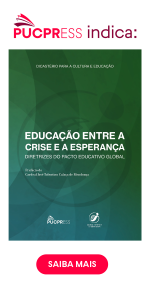Mission in the Asian Multi-religious Context
DOI:
https://doi.org/10.7213/2175-1838.10.003.DS04Palavras-chave:
Mission. Religious diversity. Change. Cultural context.Resumo
The present moment is a time of great promise because of globalisation, technological advancement, growth in communication facilities and internet. People have come closer and become more interdependent. Yet, at the same time, increased violence, a growing forgetfulness of God, and consequent feelings of fear and insecurity have become a reality in the world over, particularly in Asia. Furthermore, such phenomena as religious fanaticism and terrorism threaten our future hopes. In this situation, we have to rediscover the meaning of the Christian mission in the emerging context. As the Church evangelises in a real world that is constantly changing, the emphasis in the activities of the church also changes with time. A new understanding of evangelization in the multiple context and new tools which should be used is the need of the time to make the Gospel relevant today.
Downloads
Métricas
Referências
AMALADOSS, M. Evangelisation as Dialogue. Indian Theological Studies, n. 1, Mar. 2011.
BEVANS, B. S. Unravelling a “Complex Reality: Six Elements of Mission”. International Bulletin of Missionary Research, v. 27, n. 2, 2003.
BUBER, M. I and thou. Burlington: Kaufmann Ed., 1970.
BURROWS, W. R. A Response to Michael Amaladoss. Proceedings of the Catholic Theological Society of America, v. 56, 2001.
BOSCH, D. J. Transforming Mission. New York: Orbis, 1991.
INDIAN THEOLOGICAL ASSOCIATION [ITA]. Theologizing in Context: Statements of the Indian Theological Association Statements from the year 1980 to 2001.
Bangalore: Dharmaram Publications, 2002. Edition organized by Jacob Parappally.
JOÃO PAULO II. Redeptoris missio. São Paulo: Paulinas, 1990.
JOHN PAUL II. Discourse to the XIX Assembly of C.E.L.AM. (Port au Prince, 9 March 1983), 3: AAS 75, 1983.
KAROKARAN, A. Evangelisation and Diakonia & The Person of Jesus Christ…of Missionary Proclamation. IMR 16, p. 82-83, 1, 1978.
NAMITA. A New Paradigm for Evangelisation in the Third Millennium. Bangalore: St. Peter’s Pontifical Institute Publications, 2000.
PUTHANANGADY, P. What does Evangelisation mean in the Indian Context? Kristu Jyoti, v. 8, Mar. 1992.
STANISLAUS, L.; D’SOUZA, A. (Eds.). Prophetic Dialogue: Challenges and Prospects in India. Pune: Ishvani Kendra/Delhi: ISPCK, 2003.
TAN, J. Y. From ‘Missio ad gentes’ to ‘Missio inter Gentes’. I.: Shaping a New Paradigm for Doing Christian Mission in Asia. Vidyajyoti Journal of Theological Reflection, v. 68, n. 9, p. 670-686, Sep. 2004.
Downloads
Publicado
Como Citar
Edição
Seção
Licença
O(s) autor(es) transfere(m), por meio de cessão, à EDITORA UNIVERSITÁRIA CHAMPAGNAT, pessoa jurídica de direito privado, inscrita no CNPJ/MF sob o n.º 76.659.820/0009-09, estabelecida na Rua Imaculada Conceição, n.º 1155, Prado Velho, CEP 80.215-901, na cidade de Curitiba/PR, os direitos abaixo especificados e se compromete a cumprir o que segue:
- Os autores afirmam que a obra/material é de sua autoria e assumem integral responsabilidade diante de terceiros, quer de natureza moral ou patrimonial, em razão de seu conteúdo, declarando, desde já, que a obra/material a ser entregue é original e não infringe quaisquer direitos de propriedade intelectual de terceiros.
- Os autores concordam em ceder de forma plena, total e definitiva os direitos patrimoniais da obra/material à EDITORA UNIVERSITÁRIA CHAMPAGNAT, a título gratuito e em caráter de exclusividade.
- A CESSIONÁRIA empregará a obra/material da forma como melhor lhe convier, de forma impressa e/ou on line, inclusive no site do periódico da EDITORA UNIVERSITÁRIA CHAMPAGNAT, podendo utilizar, fruir e dispor do mesmo, no todo ou em parte, para:
- Autorizar sua utilização por terceiros, como parte integrante de outras obras.
- Editar, gravar e imprimir, quantas vezes forem necessárias.
- Reproduzir em quantidades que julgar necessária, de forma tangível e intangível.
- Adaptar, modificar, condensar, resumir, reduzir, compilar, ampliar, alterar, mixar com outros conteúdos, incluir imagens, gráficos, objetos digitais, infográficos e hyperlinks, ilustrar, diagramar, fracionar, atualizar e realizar quaisquer outras transformações, sendo necessária a participação ou autorização expressa dos autores.
- Traduzir para qualquer idioma.
- Incluir em fonograma ou produção audiovisual.
- Distribuir.
- Distribuir mediante cabo, fibra ótica, satélite, ondas ou qualquer outro sistema que permite ao usuário realizar a seleção da obra ou produção para recebê-la em tempo e lugar previamente determinados por quem formula a demanda e nos casos em que o acesso às obras ou produções se faça por qualquer sistema que importe em pagamento pelo usuário.
- Incluir e armazenar em banco de dados, físico, digital ou virtual, inclusive nuvem.
- Comunicar direta e/ou indiretamente ao público.
- Incluir em base de dados, arquivar em formato impresso, armazenar em computador, inclusive em sistema de nuvem, microfilmar e as demais formas de arquivamento do gênero;
- Comercializar, divulgar, veicular, publicar etc.
- Quaisquer outras modalidades de utilização existentes ou que venham a ser inventadas.
- Os autores concordam em conceder a cessão dos direitos da primeira publicação (ineditismo) à revista, licenciada sob a CREATIVE COMMONS ATTRIBUTION LICENSE, que permite o compartilhamento do trabalho com reconhecimento da autoria.
- Os autores autorizam a reprodução e a citação de seu trabalho em repositórios institucionais, página pessoal, trabalhos científicos, dentre outros, desde que a fonte seja citada.
- A presente cessão é válida para todo o território nacional e para o exterior.
- Este termo entra em vigor na data de sua assinatura e é firmado pelas partes em caráter irrevogável e irretratável, obrigando definitivamente as partes e seus sucessores a qualquer título.
- O não aceite do artigo, pela EDITORA UNIVERSITÁRIA CHAMPAGNAT, tornará automaticamente sem efeito a presente declaração.



